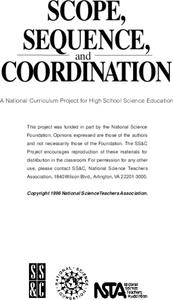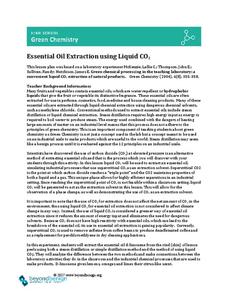Curated OER
Review of Ionic and Covalent Compounds and Transitioning from Ionic to Covalent Compounds
Here is a unique assigment: compare and contrast ionic and covalent compounds in an extensive data table and then analyze Lewis dot structures in antoher. Three columns are to befilled in: "characteristic or feature," "applies to ionic...
Curated OER
Amazing Carbon
Explore carbon and bonding with this worksheet. First, class members read a short excerpt about carbon and its characteristics. In response to the reading, they draw an electron dot diagram of carbon as well as diagrams of compounds...
Curated OER
How Are The Properties of Covalent Compounds Influenced By Chemical Bonding?
Students work together to observe the bond lengths of single, double and triple bonds. They make their own predictions about the strength of the bonds and chemical reactions. They answer discussion questions to complete the...
Curated OER
Matter and Energy
Does the change in energy of matter lead to a change in mass? Upcoming chemists compare the mass of equal-volume, but different-temperature liquids and materials both before and after a chemical reaction has occurred. In another...
Curated OER
The Nature of Covalent Bonding
In "The Nature of Covalent Bonding," chemistry hopefuls demonstrate an understanding of various types of covalent bonds, electron configuration, and resonance structures through fill in the blank, true or false, and matching questions....
Curated OER
Hydrocarbons
Making models is always memorable. In this activity, physical science starters examine the structure of hydrocarbons using marshmallows, raisins, and toothpicks. They even act as atoms themselves and link arms to represent covalent...
Curated OER
Thirty Exponential Application Problems
In this exponential worksheet, students solve thirty application problems. These problems cover compound interest, continuously compounded interest, and exponential growth models.
Curated OER
Hydrocarbons
For this chemistry worksheet, students use the clues given at the bottom of the sheet to complete the crossword puzzle on hydrocarbons. There are 17 statements to solve and fill in on the puzzle.
Curated OER
Simple Organic Compounds
In this organic compounds worksheet, students review 8 terms associated with hydrocarbon molecules. Students find these 8 terms in a word search.
Curated OER
Unit 3 Bonding
An organized table charting the different types of chemical bonds arrays this resource. The octet rule, ionization energy, and the naming of compounds are also reviewed. Young chemists answer review questions in multiple choice fashion....
Curated OER
Density Lab Activities
Young scholars participate in several density lab activities in order to clarify the misconceptions that solids sink and liquids float. Students work with triple beam balances to find mass of objects to calculate density.
Curated OER
Molecular Modeling Activity
Students explore the concept of molecular modeling and differentiate between saturated and unsaturated compounds. In small groups, they identify molecular formulas, complete a chart comparing alkanes, alkenes, and alkynes, and construct...
Curated OER
Exponential and Logarithmic Equations
In this Algebra II/Pre-calculus worksheet, students solve logarithmic and exponential equations in problem solving situations. The three page worksheet contains eleven problems. Answers are not provided.
Beyond Benign
Essential Oil Extraction Using Liquid CO2
When life hands you lemons ... experiment on them! Green chemistry gurus compare extraction methods for essential oils through a lab activity. Lab groups use traditional distillation and liquid carbon dioxide extraction...
Curated OER
Organic Chemistry-Understanding Organic Reactions
In this organic reactions worksheet, high schoolers are given descriptions of the seven types of reaction of organic compounds. They then answer six questions about these reactions.
Curated OER
Section 4.2: Ionic and Covalent Bonding
There are only six short answer questions on this assignment. Chemists explain electrical conduction properties of salt, salt water, and gold. They compare ionic and covalent bonds. The explain bond strengths. Perhaps you could use this...
American Chemical Society
Represent Bonding with Lewis Dot Diagrams
Lewis dot diagrams, Lewis dot structures, and electron dot diagrams are all the same thing. Young scientists learn how to draw Lewis dot diagrams and come to understand how dots and dashes represent valence electrons and ionic or...
Curated OER
Hydrocarbons
This worksheet would provide a great assessment for teachers to test student knowledge. High schoolers are asked to complete 3 charts which characterize types of chemical bonds such as alkanes, alkenes, or alkynes. They must also...
Curated OER
Bhopal - Covalent Bonding
Using the chemicals that leaked in the Bhopal gas tragedy of 1984, chemists examine covalent bonds. Provide for them the chemical reactions and have them draw Lewis diagrams for the molecules involved. That's about all there is to the...
Curated OER
Density Challenge
Students calculate the densities of several liquids that appear similar. In this physical science instructional activity, students go beyond understanding the way liquids of different densities behave to researching how this...
Curated OER
Molecular Models Laboratory
Students use models to visualize molecular structures. Students read about Lewis dot structures, hybridization, and formal charge. Then students build and draw the molecules and ions given. Students complete 11 pre-lab questions and 4...
Curated OER
Ionic and Covalent Bonds
Ionic and covalent bonds are the focus of this chemistry activity, which provides learners with eighteen key terms to use in a fill-in-the-blank activity. Additionally, students are prompted to write the number of atoms in four given...
Curated OER
Hybridization and Valence Bond Theory
In this chemistry instructional activity, students use knowledge of valance bonds in order to answer the in depth application of science problems.
Curated OER
Creating Bonds
In this creating bonds worksheet, students create 2-D and 3-D models of the molecular formula provided. Students complete a chart of information about the molecular formula given.























